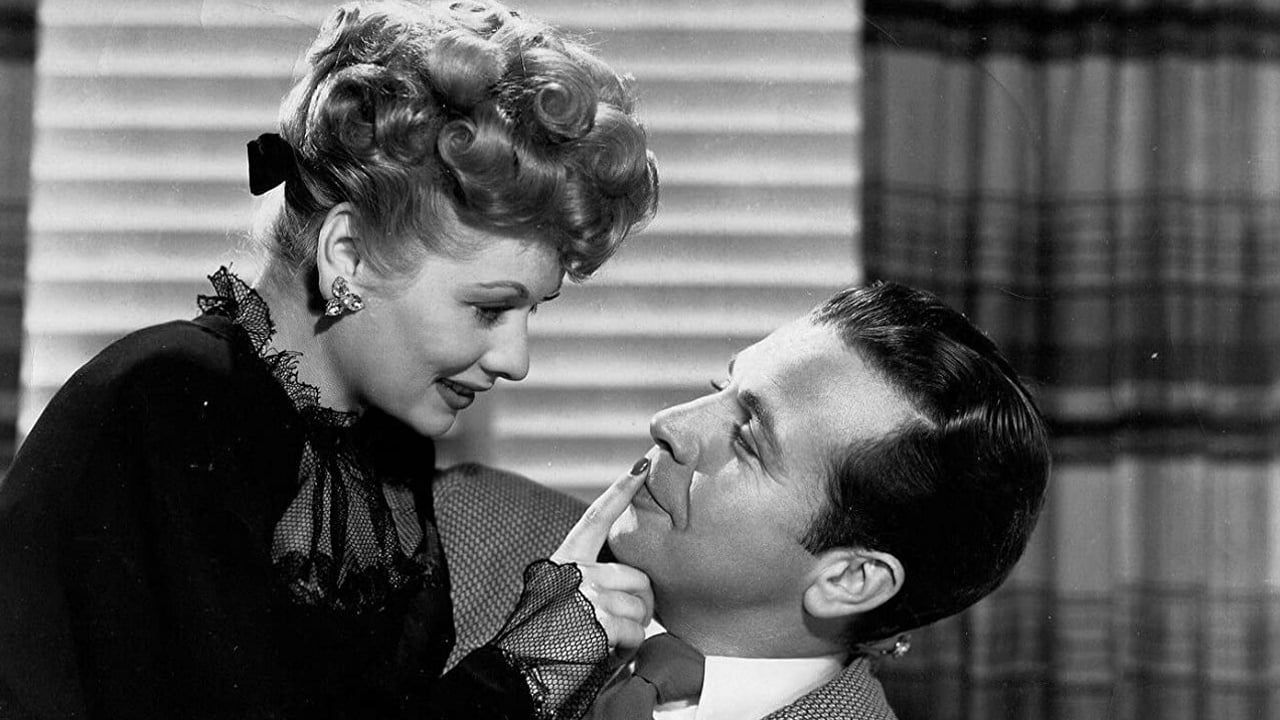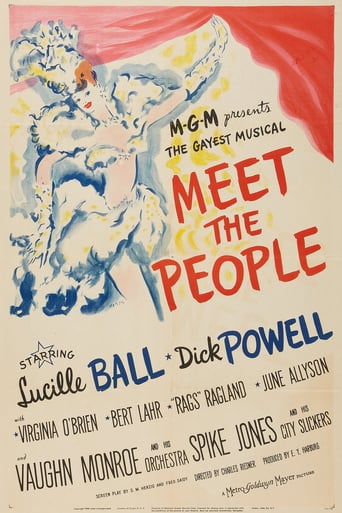

The songs are ridiculous. What Hitler is portrayed by a monkey, which is appropriate, the words were inane, especially when they kept saying his real last name- Shikelgruber.At his first song, Vaughan Monroe sounded as though he had his jaw wired. June Allyson belting out I Don't Recognize This Song was also inane, as the words were silly.As shown in your page, Lucy as Julie Hampton, was a Broadway star and not a Hollywood luminary. She is caught up with Dick Powell, a shipbuilder, who has written a play Meet the People. The two, of course, fall in love, but tangle over what kind of version his play should take, he wants it centered around the ship-builders and the people of war-time and she prefers a more glamorous rendition. He later accuses her of using the play for publicity. What was the headline about jobs being frozen causing the Ball character to remain among the ship-folk?Bert Lahr also appears, but his funniest scene is where a tuba practically goes on top of his nose.Silly fanfare with the predictable ending.
... View MoreIt's curious that the two stars of Meet The People were a pair of movie stars who went into the new medium of television and became even bigger successes and who both went into the production end of things and enjoyed tycoon status on the small screen. Lucille Ball however was not a major star, that would come with television. As for Dick Powell he desperately wanted to get out of doing films like Meet The People and his career salvation would be coming in his next film.I think the only reason that Dick Powell did the film was because a young player from MGM was cast in a specialty number and he was seeing her at the time. His private time with June Allyson was far better than what we see on the screen. Powell looks crashingly bored and can't summon up any kind of emotion at all.He was probably tired of doing these musicals with silly plots, the kind he ran from Warner Brothers from. The original show Meet The People was not a book show, it was a revue and it ran in the 1940-41 season on Broadway for 160 performances. When MGM bought it, they scrapped everything but the title and the title song. The rest of the score was patched together from various and sundry songwriters, none of the songs is memorable. Odd when you consider some of the source material is from Burton Lane, E.Y. Harburg, Harold Arlen, and Rodgers&Hart. These guys just must have emptied the trunk for material.The plot is sillier than even most of the musical propaganda pieces of the time. Powell is the writer of a revue called Meet The People and he's a shipyard worker who wins a lottery date with movie star Lucille Ball. She's interested, he's interested, they're both interested in the revue, but creative differences keep them apart of course until the finale. That's the film in a nutshell.MGM did give Powell and Ball some good musical acts which are the main reason for watching Meet The People. The big bands of Vaughn Monroe and Spike Jones are here and the highlight of the film for me is Bert Lahr dressed in a commodore's suit like Lou Costello had in the dream sequence in In The Navy. The song Heave Ho is written by Arlen and Harburg who wrote for Lahr, the Courage number from The Wizard Of Oz. And as just about everyone in the world has seen that film, you have an idea of Heave Ho is like.Dick Powell's next film was Murder My Sweet in which he finally bid a not so fond adieu to musicals. And Lucy would have to wait for television before the world got to see what she really could do.
... View MorePersonally I think several of the opinions here are awfully harsh and take unfair advantage of 20/20 hindsight. Yes, WW2 was horrible--- and you've got innumerable references to topical characters that've faded from the average person's knowledge. But a Ken Burns documentary this ain't! Valid criticism: it suffers from being an MGM musical shot in black & white with a 40-year old Dick Powell who'd had his more than his fill of such stuff. But there's a lot it on the plus side too: Virginia "The Shynx" O'Brian is terrific, June Allyson (possibly where she first met Dick?), Bert Lahr doing some of his finest signature work (it left me wondering why he was never in the running for the Fred Mertz role--- the cast seemed to love him) and honestly, Lucille Ball looks amazing, dubbed voice and all. And there's also the seemingly incongruent mix of Spike Jones and Vaughan Monroe. The stage version was already several years old and several of the (admittedly unremarkable) songs were updated for the war effort. Look for MGM-contract star Mickey Rooney's dad, Joe Yule, in the role of "Shorty," Bobby Blake doing his best to remain on the Metro lot during the waning days of Our Gang and Rags Ragland, less than two years away from his very premature death. This is an entertaining, very loose stage adaption of a modest Broadway hit geared to wartime audiences just wanting to be entertained. Far from a classic but worth watching.
... View MoreFor having been made at MGM, "Meet the People", didn't get the usual treatment by the studio. The film was shot in black and white and there are no lavish production numbers. The movie was based on a musical revue that played in Los Angeles during WWII. It has its share of propaganda, since most of the action takes place around a navy yard where war ships were constructed.The best thing in the film are some of the songs that were composed for it. The best song heard on the film is "I Like to Recognize the Tune", composed by Richard Rogers and Laurenz Hart. The other great number is one in which Spike Jones and his City Slickers appear dressed as Mussolini, Hitler, and figures on the wrong side of the war, as they sing a parody of a sextet of "Lucia di Lamermoor".Lucille Ball plays Julie Hampton. She was at the height of her good looks and cut a lovely figure. Her love interest is played by Dick Powell, an actor with a lovely manly voice who was also at a good point of his career. Bert Lahr, Virginia O'Brien and a young June Allyson, soon to be Mrs. Dick Powell, appear in supporting roles.The film was directed by Charles Reisner and the black and white cinematography was by Robert Surtees that has kept its crispness in spite of having been shot more than sixty years ago. The film would be a curiosity piece by fans of Lucille Ball.
... View More